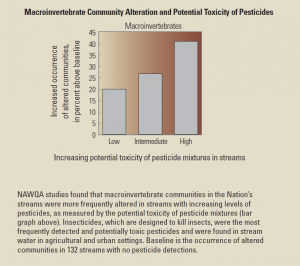19
Jul
Federal Report Finds Stream Health Severely Degraded
(Beyond Pesticides, July 19, 2013) A recent report by the U.S. Geological Survey (USGS) examines the health of the nation’s streams over 20 years and finds that streams nationwide are severely degraded by humans, exhibiting elevated levels of pesticides and nutrients as well as streamflow modifications. Overall, the report finds that 83 percent of streams in agricultural and urban areas contain at least one aquatic community that was altered, or in other words, negatively affected.
With waterways in the U.S. increasingly imperiled from various agents including agricultural and industrial discharges, nutrient loading (nitrogen and phosphorus), and biological agents such as pathogens, assessments such as these provide further impetus to protect water quality for both human health and the environment.
The report, entitled “Quality of Our Nation’s Waters: Ecological Health in the Nation’s Streams, 1993-2005,” describes the health of three biological communities ””algae, macroinvertebrates, and fish”” to measure the overall quality of streams. A stream’s ability to support these community structures can directly measure the health of waterways. The report assesses streamflow modifications and measures over 100 chemical constituents in water and streambed sediments. The report is a comprehensive assessment of the variety of factors that contribute to stream health declines, notably runoff from pesticides and contaminants.
Daren Carlisle, Ph.D., an ecologist with the USGS and the lead author of the study, told Michigan Public Radio, “If you were feeling sick and went to the doctor and all they did was took your temperature, you’d say, ‘hey, wait a minute there’s more to this than that.'” He continues, “What we’re learning from this big assessment is just how many parts of the ecosystem need to be monitored and integrated together in order to really understand ‘what do we need to go fix now?'”
The assessment reveals several areas that need fixing as stream health has been severely degraded throughout the nation. Indeed, only one in five streams in agricultural and urban areas are considered relatively healthy, and those are streams that tend to have little physical modifications and less runoff from roads and agricultural areas.
As far as pesticides and contaminants are concerned, the report concludes that:
- Urban streams have pesticide concentrations that exceed one or more benchmarks at 83 percent of sites. The most frequently detected pesticides in urban streams are chlorpyrifos (a highly toxic organophosphate insecticides widely used in the US), carbaryl (a carbamate insecticide and contact nerve toxin), and diazinon (an organophosphate insecticide effecting the nervous system), all highly toxic pesticides that caused changes in macroinvertebrate communities.
- Agricultural streams have concentrations that exceed one or more benchmarks at 57 percent of sites. The most frequently detected pesticides in agricultural stream are chlorpyrifos, azinphos-methyl, atrazine, dichlorodiphenyldichloroethylene (a breakdown product of DDT), and alachlor.
- The frequency of altered macroinvertebrate communities increased from 20 to 42 percent as the potential toxicity of pesticide mixtures in stream water samples increased. Similarly, the frequency of altered macroinvertebrate communities increased from 23 to 51 percent as the potential toxicity in sediment contaminants increased.
- Streams with insecticide levels that exceed U.S. Environmental Protection Agency (EPA) Aquatic-Life Benchmarks have 12 percent fewer macroinvertebrate taxa than streams that did not exceed the benchmarks.
Collectively, these findings show that elevated pesticide and contaminant levels altered community levels by as much as 51 percent, with many pesticides are considered highly toxic to aquatic life. The report concludes that, “Elevated concentrations of dissolved pesticide mixtures in stream water and contaminant mixtures in stream sediments have a high potential to diminish stream health across the Nation.”
While the report does not provide recommendations beyond the need to fill information gaps for understanding the ecological health of streams, the report does provide context for the interaction between human caused contaminants, pesticides, and streamflow modifications on the stream quality.
Previous USGS reports have documented pesticides and fertilizers in U.S. streams and drinking water. Herbicides like atrazine, metalachlor, and simizine are among those often found in surface waters of 186 rivers and streams sampled by USGS since the early 1990s, and are highly correlated with the presence of upstream wastewater sources or upstream agricultural and urban land use. Recently, USGS released a national assessment that shows the distribution and trends of pesticide use from 1992-2009, providing visible evidence that contamination of pesticides in our nation’s water is clearly a continuing threat.
Meanwhile, regulations that protect U.S. waterways from chemical contamination, including contamination from pesticides, have been attacked by industry groups and Congress. Under the Clean Water Act (CWA), pesticide users who spray over waterways must have a National Pollutant Discharge Elimination System (NPDES) permit. This requirement follows a 2009 federal appeals court ruling in National Cotton Council v. EPA, and simply lets authorities know what is sprayed and when it is sprayed, so that the public may know what chemicals are used in their waterways. However, since the enaction of the NPDES permit requirement, in 2011, several pieces of legislation have been introduced in Congress that would eliminate these regulations.
In May, the Sensible Environmental Protection Act was introduced by Senator Kay Hagan (D-NC), with support from Larry Wooten, president of the North Carolina Farm Bureau, to eliminate NPDES permits. The claim from industry lobby groups is often that these permits are burdensome on farmers and costly, though fees can be as low as $25 for the permit, and states that oversee the permitting program stand to collect this revenue. For more information read Clearing up the Confusion Surrounding the New NPDES General Permit.
Learn more about the health of our nation’s streams, from water quality surveys to peer-reviewed research relating the impact of pesticides on human health and the environment. To keep up to date on Congressional and government agency actions, sign-up for Beyond Pesticides’ action alerts and visit our Threatened Waters page.
Source: USGS, USGS Newsroom
Photo Source: USGS
All unattributed positions and opinions in this piece are those of Beyond Pesticides.










